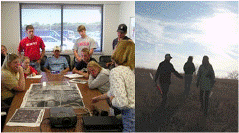Environmental and Sustainability Studies Program

Department of Environmental Studies: Undergraduate Student Theses
Date of this Version
Spring 5-2011
Document Type
Thesis
Abstract
Ancient cultures of the Colorado Plateau have been a focus of archaeoparasitology since its inception, and a vast parasitological history is recorded in coprolites preserved in this arid region. The inhabitants of Chaco Canyon dominated Ancestral Puebloan culture between 1050 and 1120 AD and were responsible for the construction of great towns, road systems, and early agriculture. Analysis of the parasites preserved in fecal remains contributes to an increased knowledge of ancient Chacoan health and culture. Nineteen coprolites from four sites in Chaco Canyon were rehydrated and analyzed microscopically for parasite remains. Rhabditiform and filariform nematode larvae were found from several sites. Though these larvae closely resemble Ancylostoma duodenale or Strongyloides stercolaris, morphological characters indicate that most likely they were free-living species infesting the feces. Pinworm (Enterobius vermicularis) eggs were found at two sites, implying that population aggregation in Chacoan great houses contributed to disease transmission. This study presents the first record of whipworm (Trichuris trichiura) among Ancestral Puebloans. Another whipworm from an Archaic site at Chaco Canyon dated to approximately 900 BC represents the first Archaic parasite found on the Colorado Plateau. This species requires warm, moist soil for life cycle completion. Since these conditions are not naturally present on the Colorado Plateau, the presence of T. trichiura can be attributed to an alteration of the environment through irrigation agriculture and the construction of large, communal dwellings. The presence of this species also suggests that the inhabitants of Chaco Canyon had frequent contact with Mesoamerican civilizations.
Included in
Environmental Health Commons, Environmental Sciences Commons, Indigenous Studies Commons, Organismal Biological Physiology Commons, Parasitology Commons, Pathogenic Microbiology Commons

